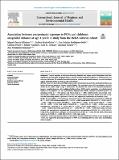Por favor, use este identificador para citar o enlazar a este item:
http://hdl.handle.net/10261/216879COMPARTIR / EXPORTAR:
 SHARE SHARE
 CORE
BASE CORE
BASE
|
|
| Visualizar otros formatos: MARC | Dublin Core | RDF | ORE | MODS | METS | DIDL | DATACITE | |

| Título: | Association between pre/perinatal exposure to POPs and children's anogenital distance at age 4 years: A study from the INMA-Asturias cohort |
Autor: | García-Villarino, Miguel; Riaño-Galán, Isolina; Rodríguez-Dehli, Ana Cristina; Freire, Carmen; Vizcaíno, Esther CSIC ORCID; Grimalt, Joan O. CSIC ORCID ; Tardón, Adonina; Fernández-Somoano, Ana | Palabras clave: | Anogenital distance Anogenital index Persistent organic pollutants Endocrine disruptor Genital development |
Fecha de publicación: | jul-2020 | Editor: | Elsevier | Citación: | International Journal of Hygiene and Environmental Health 229: 113563 (2020) | Resumen: | Background Prenatal exposure to endocrine-disrupting chemicals may impair genital development and alter reproductive tract anatomy. Anogenital distance (AGD) is a useful biomarker of exposure to chemicals that act as endocrine disruptors. We evaluated associations between prenatal and perinatal exposure to several persistent organic pollutants (POPs) and AGD in 4-year-old children. Methods Data were drawn from the INMA-Asturias cohort. Pediatricians measured the anofourchetal distance in female children and anoscrotal distance in male children. The anogenital index (AGI) was defined as the AGD divided by the child's weight at age of examination. We measured the levels of two hexachlorocyclohexane isomers, hexachlorobenzene, dichlorodiphenyltrichloroethane (DDT) and its metabolites, six polychlorinated biphenyl (PCB) congeners, and six polybrominated diphenyl ether (PBDE) congeners in maternal serum at 12 gestational weeks (n = 155) and in cord blood serum (n = 229). Anthropometric and parental sociodemographic variables were collected via face-to-face interviews. Linear regression models were used to evaluate the relationship between exposure to POPs and AGI, adjusted for confounders and stratified by sex. Results In male children, we found inverse associations between AGI and maternal concentrations of PCB-138 (ß = −0.041, 95% confidence interval [CI]: −0.074, −0.008, second tertile), PCB-153 (ß = −0.052, 95% CI: −0.085, −0.020, second tertile), PCB-180 ß = −0.065, 95% CI: −0.096, −0.035, second tertile; ß = −0.042, 95% CI: −0.073, −0.011, third tertile), PBDE-209 (ß = −0.031, 95% CI: −0.058, −0.006), cord serum concentrations of PCB-153 (ß = −0.029, 95% CI: −0.059, −0.000, second tertile; ß = −0.047, 95% CI: −0.085, −0.008, third tertile), and PCB-180 (ß = −0.041, 95% CI: −0.078, −0.005, third tertile). In female children, AGI was positively associated with maternal serum concentrations of PCB-101 (ß = 0.039, 95% CI: 0.002, 0.076, second tertile), and higher cord serum levels of 4,4′-DDT (ß = 0.032, 95% CI: 0.003, 0.061, third tertile) and 4,4′-DDE (ß = 0.040, 95% CI: 0.011, 0.069, third tertile). Conclusions Our findings provide evidence of associations between specific POPs and AGI in boys and girls aged 4 years, and suggest that pre/perinatal exposure to POPs has a feminizing effect in males and a masculinizing effect in females. | Versión del editor: | https://doi.org/10.1016/j.ijheh.2020.113563 | URI: | http://hdl.handle.net/10261/216879 | DOI: | 10.1016/j.ijheh.2020.113563 |
| Aparece en las colecciones: | (IDAEA) Artículos |
Ficheros en este ítem:
| Fichero | Descripción | Tamaño | Formato | |
|---|---|---|---|---|
| Association between preperinatal exposure to POPs and children's anogenital distance at age 4 years.pdf | Artículo principal | 473,28 kB | Adobe PDF |  Visualizar/Abrir |
| 1-s2.0-S1438463920305095-mmc1.docx | Material suplementario | 594,09 kB | Microsoft Word XML | Visualizar/Abrir |
CORE Recommender
SCOPUSTM
Citations
17
checked on 08-may-2024
WEB OF SCIENCETM
Citations
11
checked on 28-feb-2024
Page view(s)
129
checked on 15-may-2024
Download(s)
130
checked on 15-may-2024
Google ScholarTM
Check
Altmetric
Altmetric
NOTA: Los ítems de Digital.CSIC están protegidos por copyright, con todos los derechos reservados, a menos que se indique lo contrario.
